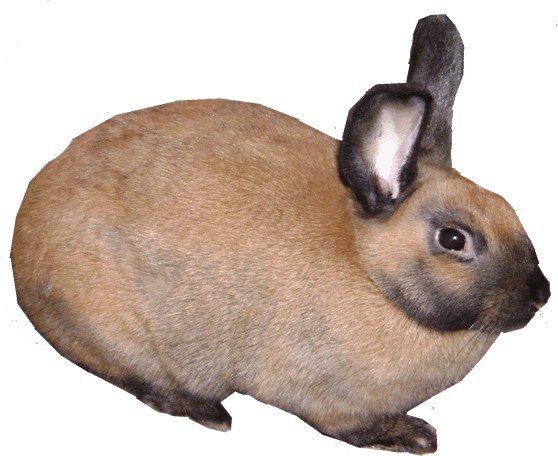Type the name of the breed you're looking for below
[wpdreams_ajaxsearchlite] Don't see the breed your're looking for? Click here and let us know!
Breed Characteristics
1 paw - breed exhibits the least amount of this characteristic
5 paws - breed exhibits most amount of this characteristic
Cinnamon rabbit
| Origin | The Cinnamon rabbit was actually created accidentally by two children, Belle and Fred Houseman, during the Easter season of 1962 in Missoula, Montana. After crossbreeding their Chinchilla doe and their New Zealand buck, the children’s father, Ellis Houseman, let the children keep one crossbred buck. After joining their local 4-H group, the children were given a Checkered Giant doe and a crossed Californian doe. After mating the crossed buck with each doe, the Californian doe produced one russet-colored bunny in its litter and the Checkered Giant eventually produced two bunnies with this russet-colored fur (one doe and one buck.) Ellis Houseman believed that only purebred rabbits should be kept for show, but he reluctantly allowed his children to keep the pair of russet-colored bunnies from the Checkered Giant’s last litter. The children mated this pair together, and 70 percent of the litter had this new auburn shade of fur, which they began calling Cinnamon. Ellis noticed this new color and the fur’s excellent sheen, and proceeded to present the rabbits to J. Cyril Lowett, Oregon ARBA Judge and board member at the time. Lowett declared that there was a strong possibility of the rabbits’ ability in becoming an official breed, as there was no other breed like them in the United States. There are a couple of requirements needed for an unrecognized breed of rabbit to become an official breed according to ARBA. The Housemans needed to have their rabbits “passed” by three different ARBA conventions. The Housemans first took their Cinnamons to the ARBA convention in Calgary, Canada in 1969. The Cinnamons were immediately approved, so the family sent them to the 1970 convention in Syracuse, New York. Unfortunately, the family could not attend and therefore sent the rabbits to Syracuse by air freight. During this trip the rabbits contracted a virus that sickened and even killed some of them, and they were not passed by the convention due to their poor form and condition. In 1971 the Housemans continued their efforts for the Cinnamons to become an official breed, and the family took the rabbits to the 1971 convention in Albuquerque, New Mexico. Again there were some obstacles- the family hit a severe storm and had to abandon their trailer, and a dog broke into their rabbitry, killing three of their best does. However, the rabbits managed to pass the convention with good comments. The family finally reached their goal in 1972, when the rabbits passed their third convention in Tacoma, Washington and were officially recognized and accepted by the ARBA’s Book of Standards. |
Physical Attributes
| Weight | 8.5 - 11 lbs. (3.9 - 5 kg) |
| Ear Type | Erect |
| Fur Type | Flyback |
| Colours | The rabbit is very striking, with rust or ground cinnamon colouring and a uniform gray ticking across the back. The rabbit has a smoky grey colouring on its sides and a dark underbelly, with an orange under-colouring all over. The rabbit has distinct rust-coloured spots inside its hind legs, and these spots often appear on its feet and face. The hind legs, feet, and face tend to be generally darker than the rest of the body. A butterfly effect marks the nose and small circles around each eye are present. |
| Appearance | The Cinnamon is medium in length and has a round body. The rabbit’s hips are deeper and wider than its shoulders, its head is proportionate to its body, and its ears are erect. |
| Other Considerations | Life Expectancy: 5-8 years Temperament: Laid-back The Cinnamon Rabbit required a well balanced diet to remain healthy. Grass hay, cecotropes, and green foods are staples in the diet of a domestic rabbit. Grass hay can consist of timothy, meadow, oat, rye, barley or Bermuda grasses. If grass hay is not available, legume hay is an acceptable alternative. Legume hay is very rich with nutrients which a domestic rabbit does not need; therefore, it should only be an alternative. Flowers, fruits and vegetables are acceptable to feed a domestic rabbit but only in small amounts, not as an entire meal. Water should be constantly available for a rabbit. All rabbit cages should NOT have mesh bottoms, because it can hurt their paws. The cage should be tall enough for the rabbit to stand on its back legs without hitting its head. The cage should be resistant to chewing, as well as big enough for the rabbit to have a rest area and a place to hide. If the rabbit is kept in a cage for the majority of the time, it should be taken out a few hours of the day for exercise to avoid health problems. Bedding such as a pelleted litter is also something that is beneficial for the rabbit’s housing |
| Best Kept In | Pen. Shed, House or Yard. |



